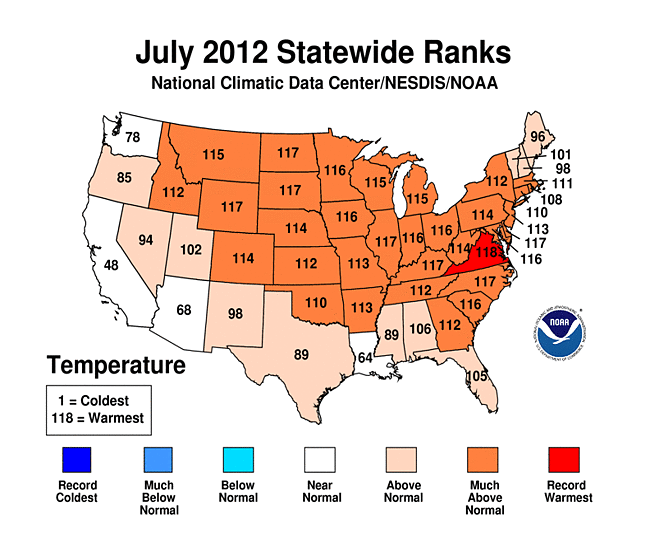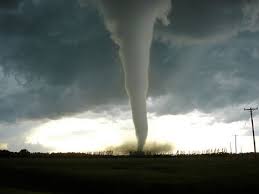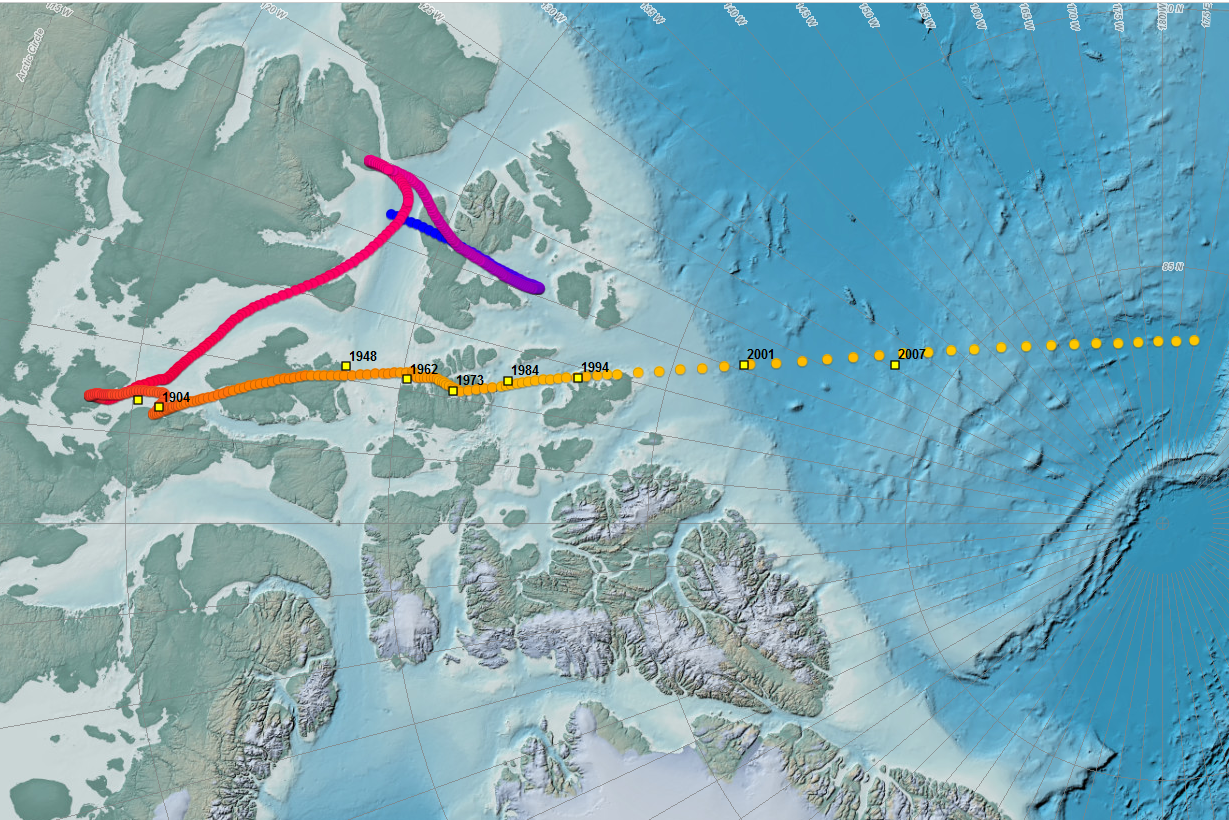U.S. suffers through hottest July since record keeping began in 1895
 August 8, 2012 – CLIMATE - The July heat wave that wilted crops, shriveled rivers and fueled wildfires officially went into the books Wednesday as the hottest single month on record for the continental United States. The average temperature across the Lower 48 was 77.6 degrees Fahrenheit, 3.3 degrees above the 20th-century average, the National Oceanographic and Atmospheric Administration reported. That edged out the previous high mark, set in 1936, by two-tenths of a degree, NOAA said. In addition, the seven months of 2012 to date are the warmest of any year on record and were drier than average as well, NOAA said. U.S. forecasters started keeping records in 1895.And the past 12 months have been the warmest of any such period on record, topping a mark set between July 2011 and this past June. Every U.S. state except Washington experienced warmer-than-average temperatures, NOAA reported. The high temperatures have contributed to a ‘rapid expansion’ of drought across the central United States, NOAA found. Dozens of cities and towns already have seen the mercury hit record levels this summer, and three states — Nebraska, Kansas and Arkansas — saw record dry conditions between May and July. That’s battered American farmers’ corn and soybean crops, driven farmers to sell or slaughter cattle they can’t feed and spurred the U.S. Department of Agriculture to designate more than half of all U.S. counties as disaster zones. –CNN
August 8, 2012 – CLIMATE - The July heat wave that wilted crops, shriveled rivers and fueled wildfires officially went into the books Wednesday as the hottest single month on record for the continental United States. The average temperature across the Lower 48 was 77.6 degrees Fahrenheit, 3.3 degrees above the 20th-century average, the National Oceanographic and Atmospheric Administration reported. That edged out the previous high mark, set in 1936, by two-tenths of a degree, NOAA said. In addition, the seven months of 2012 to date are the warmest of any year on record and were drier than average as well, NOAA said. U.S. forecasters started keeping records in 1895.And the past 12 months have been the warmest of any such period on record, topping a mark set between July 2011 and this past June. Every U.S. state except Washington experienced warmer-than-average temperatures, NOAA reported. The high temperatures have contributed to a ‘rapid expansion’ of drought across the central United States, NOAA found. Dozens of cities and towns already have seen the mercury hit record levels this summer, and three states — Nebraska, Kansas and Arkansas — saw record dry conditions between May and July. That’s battered American farmers’ corn and soybean crops, driven farmers to sell or slaughter cattle they can’t feed and spurred the U.S. Department of Agriculture to designate more than half of all U.S. counties as disaster zones. –CNN


 Magnetic pole migration: If you look at the data, we find something even more intriguing than just the high temperatures. From looking at the two maps, we can see the high temperatures are migrating farther north. This indicates major changes are occurring to the planet’s jet stream. Basically, the jet stream is moving farther north into Canada, and this is shifting U.S. weather patterns northward in the process. I documented this change was well underway in my book, The 7th Protocol, along with the future implications for climate that will result from this erratic migration of the planet’s jet stream. This shifting atmospheric dynamism will continue to have a profound impact on the world’s climate. It will also further accentuate seasonal temperature extremes, as the jet stream in closely linked with the planet’s electrical and geo-magnetic properties, which are constantly perturbed by solar activity. –The Extinction Protocol
Magnetic pole migration: If you look at the data, we find something even more intriguing than just the high temperatures. From looking at the two maps, we can see the high temperatures are migrating farther north. This indicates major changes are occurring to the planet’s jet stream. Basically, the jet stream is moving farther north into Canada, and this is shifting U.S. weather patterns northward in the process. I documented this change was well underway in my book, The 7th Protocol, along with the future implications for climate that will result from this erratic migration of the planet’s jet stream. This shifting atmospheric dynamism will continue to have a profound impact on the world’s climate. It will also further accentuate seasonal temperature extremes, as the jet stream in closely linked with the planet’s electrical and geo-magnetic properties, which are constantly perturbed by solar activity. –The Extinction Protocol


Tornadoes: “In the United States, July 2012 saw one of the lowest numbers of tornadoes on record since 1951. The jet stream responsible for tornado-producing wind shear moved farther north into Canada. The result was a burst in tornado activity in the Canadian province of Saskatchewan, which borders Montana and North Dakota. Canada’s official weather office Environment Canada reported between 26 and 31 tornadoes in Saskatchewan, more than double the province is used to seeing in July. On July 24, five tornadoes hit Saskatchewan in one day.” –Accuweather - August 2, 2012
(Left) Magnetic north pole migration and magnetic south pole movements indicates there are periods when the poles have moved farther and faster than others.
 August 8, 2012 – CLIMATE - The July heat wave that wilted crops, shriveled rivers and fueled wildfires officially went into the books Wednesday as the hottest single month on record for the continental United States. The average temperature across the Lower 48 was 77.6 degrees Fahrenheit, 3.3 degrees above the 20th-century average, the National Oceanographic and Atmospheric Administration reported. That edged out the previous high mark, set in 1936, by two-tenths of a degree, NOAA said. In addition, the seven months of 2012 to date are the warmest of any year on record and were drier than average as well, NOAA said. U.S. forecasters started keeping records in 1895.And the past 12 months have been the warmest of any such period on record, topping a mark set between July 2011 and this past June. Every U.S. state except Washington experienced warmer-than-average temperatures, NOAA reported. The high temperatures have contributed to a ‘rapid expansion’ of drought across the central United States, NOAA found. Dozens of cities and towns already have seen the mercury hit record levels this summer, and three states — Nebraska, Kansas and Arkansas — saw record dry conditions between May and July. That’s battered American farmers’ corn and soybean crops, driven farmers to sell or slaughter cattle they can’t feed and spurred the U.S. Department of Agriculture to designate more than half of all U.S. counties as disaster zones. –CNN
August 8, 2012 – CLIMATE - The July heat wave that wilted crops, shriveled rivers and fueled wildfires officially went into the books Wednesday as the hottest single month on record for the continental United States. The average temperature across the Lower 48 was 77.6 degrees Fahrenheit, 3.3 degrees above the 20th-century average, the National Oceanographic and Atmospheric Administration reported. That edged out the previous high mark, set in 1936, by two-tenths of a degree, NOAA said. In addition, the seven months of 2012 to date are the warmest of any year on record and were drier than average as well, NOAA said. U.S. forecasters started keeping records in 1895.And the past 12 months have been the warmest of any such period on record, topping a mark set between July 2011 and this past June. Every U.S. state except Washington experienced warmer-than-average temperatures, NOAA reported. The high temperatures have contributed to a ‘rapid expansion’ of drought across the central United States, NOAA found. Dozens of cities and towns already have seen the mercury hit record levels this summer, and three states — Nebraska, Kansas and Arkansas — saw record dry conditions between May and July. That’s battered American farmers’ corn and soybean crops, driven farmers to sell or slaughter cattle they can’t feed and spurred the U.S. Department of Agriculture to designate more than half of all U.S. counties as disaster zones. –CNN Magnetic pole migration: If you look at the data, we find something even more intriguing than just the high temperatures. From looking at the two maps, we can see the high temperatures are migrating farther north. This indicates major changes are occurring to the planet’s jet stream. Basically, the jet stream is moving farther north into Canada, and this is shifting U.S. weather patterns northward in the process. I documented this change was well underway in my book, The 7th Protocol, along with the future implications for climate that will result from this erratic migration of the planet’s jet stream. This shifting atmospheric dynamism will continue to have a profound impact on the world’s climate. It will also further accentuate seasonal temperature extremes, as the jet stream in closely linked with the planet’s electrical and geo-magnetic properties, which are constantly perturbed by solar activity. –The Extinction Protocol
Magnetic pole migration: If you look at the data, we find something even more intriguing than just the high temperatures. From looking at the two maps, we can see the high temperatures are migrating farther north. This indicates major changes are occurring to the planet’s jet stream. Basically, the jet stream is moving farther north into Canada, and this is shifting U.S. weather patterns northward in the process. I documented this change was well underway in my book, The 7th Protocol, along with the future implications for climate that will result from this erratic migration of the planet’s jet stream. This shifting atmospheric dynamism will continue to have a profound impact on the world’s climate. It will also further accentuate seasonal temperature extremes, as the jet stream in closely linked with the planet’s electrical and geo-magnetic properties, which are constantly perturbed by solar activity. –The Extinction Protocol




No comments:
Post a Comment